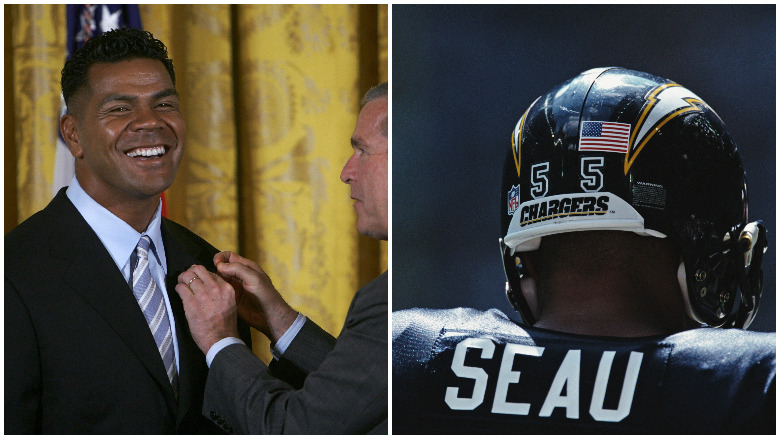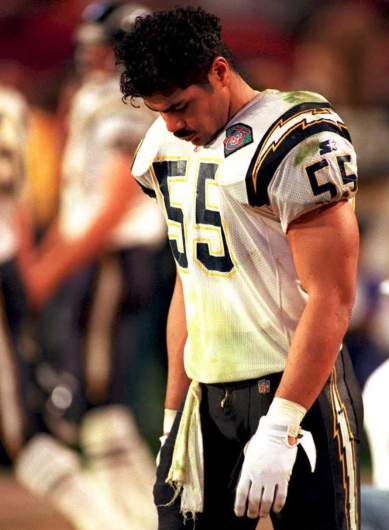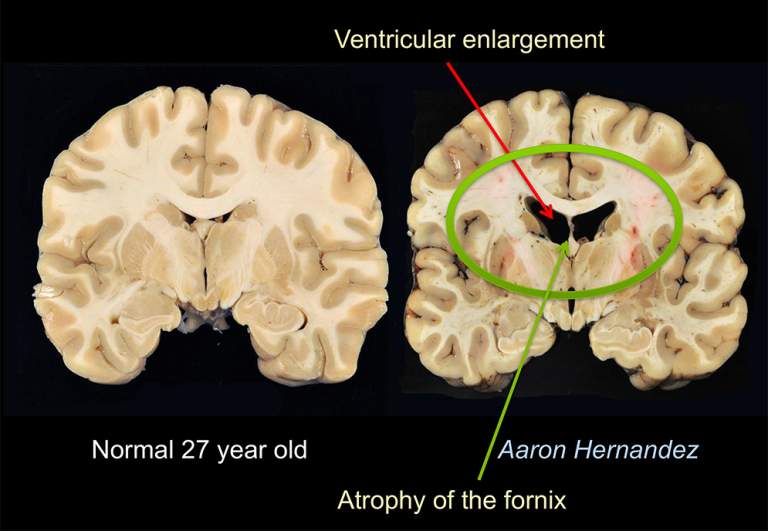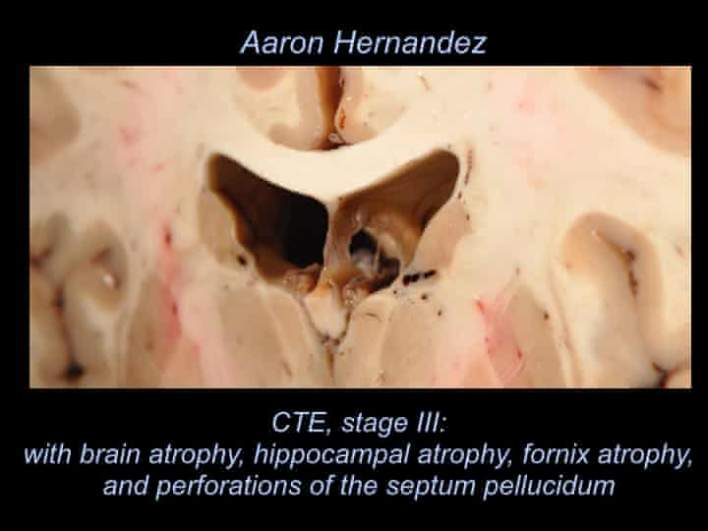
Getty Junior Seau's cause of death was suicide.
Junior Seau’s tragic death is revisited in the new Netflix documentary that explores the rise and fall of former New England Patriots’ star Aaron Hernandez.
In the Netflix documentary, Seau’s death is presented as a fatal warning sign that the dangers of CTE were all too real – but one that the NFL didn’t fully heed. There was Seau, a beloved and jovial figure, committing suicide… a canary in the mine, perhaps, of what was to come. The Week reported that Seau was considered one of the best NFL players of the 1990s. He made the Pro Bowl 12 times. He was considered to be of extraordinary character, a fist-pumping player who brought passion to the football field. No one saw it coming, although in retrospect, his erratic behavior, so out of character, toward the end, proved a warning sign.
Hernandez, of course, committed suicide in a Massachusetts prison cell, where he was serving time for the murder of Odin Lloyd, the boyfriend of his fiancee’s sister. As the Netflix documentary shows, he was also suspected in a string of other shootings and murders. Brain scans later revealed that Hernandez had the worst case of CTE that Boston University researchers had ever seen in someone his age (27).
However, what really happened to Junior Seau? What was his cause of death? How bad was his CTE?
Here’s what you need to know:
Junior Seau Committed Suicide by Shooting Himself in the Chest

San Diego Chargers star middle linebacker Junior Seau stands on the sidelines 29 January 1995 late in the game against the San Francisco 49ers during Super Bowl XXIX in Miami.
It was an inexplicable act, and a horribly tragic one. Junior Seau, a father of four, and a beloved figure on the football field, committed suicide by shooting himself in the chest at his Oceanside, California home in 2012. That was five years before Aaron Hernandez hanged himself in a Massachusetts prison cell. The San Diego County Medical Examiner’s Office declared the Seau death a suicide.
NFL.com reported that Seau texted his wife and kids that he loved him, but family members didn’t otherwise see any warning signs.
“I have no words to describe the passing of Junior Seau,” Chargers coach Norv Turner said in a statement released by the team, according to NFL.com. “It is a sad, sad day for not only me, but for the whole sports community. I worked with Junior here and later in Miami. I can tell you no one had more character and true leadership ability than Junior. He brought passion to the game of football that was unmatched. His commitment to charitable causes in the community was inspiring. It was an honor to know him. My thoughts and prayers are with his family.”
The chest may have been a purposeful decision. Why? People saw similarities to the earlier suicide, according to ESPN, of former Chicago Bears player Dave Duerson, who also shot himself in the chest. According to The Week, in 2011, Duerson left a note asking for his brain to be studied for football related trauma. The same Boston University researcher who would later study the brain of Aaron Hernandez determined that Duerson did, in fact, have CTE.
She outlined other tragedies: Wally Hilgenberg, a Minnesota Vikings linebacker; Lou Creekmur, a Detroit Lions lineman; former Houston and Miami linebacker John Grimsley. Of Grimsley, Boston University writes, “The first deceased athlete examined by the CSTE researchers was John Grimsley, former linebacker for the Houston Oilers and Miami Dolphins, who died in February 2008 at the age of 45 from an accidental gunshot wound. Examination of Mr. Grimsley’s brain confirmed extensive CTE. In both sets of photographs, below, the brain tissue has been immunostained for tau protein, which appears as a dark brown color.” You can see those photos here.
Seau’s family donated the brain to the National Institutes for Health, according to ABC News.
It was May 2012, and Seau, the former star of the San Diego Chargers, was only 43 years old. According to ESPN, these were the details at the scene: Seau’s girlfriend discovered him. The gun was found near him. There was no suicide note.
Leading up to the suicide were problematic behaviors. According to ESPN, Seau was accused of domestic violence and subsequently “survived a 100-foot plunge down a seaside cliff in his SUV.”
Researchers Determined That Junior Seau Had CTE

NFL All-Pro Junior Seau attending Dennis Rodman’s 43rd Birthday Party in the VIP room at the Highlands on May 14, 2004 in Hollywood, California.
Researchers determined that Junior Seau had CTE, or chronic traumatic encephalopathy (CTE), the brain disease caused by repeated head trauma, such as that faced by football players or boxers. According to Bleacher Report, his ex-wife Gina and son Tyler delivered the news, saying, “I think it’s important for everyone to know that Junior did indeed suffer from CTE. It’s important that we take steps to help these players. We certainly don’t want to see anything like this happen again to any of our athletes.”
“What was found in Junior Seau’s brain was cellular changes consistent with CTE,” said Dr. Russell Lonser, chairman of the Department of Neurological Surgery at Ohio State University, who led the study of Seau’s brain while he was at NIH.
You can find the NIH report on Junior Seau here. In 2016, the researchers explained, “Junior Seau, a Hall of Fame, National Football League linebacker, has been the most high-profile confirmed case of CTE.” That was before Hernandez, of course.
The NIH study found: “Since 1990, Junior Seau had a highly distinguished 20-year career playing for the National Football League as a linebacker, from which he sustained multiple concussions. He committed suicide on May 2, 2012, at age 43, after which an autopsy confirmed a diagnosis of CTE. His clinical history was significant for a series of behavioral disturbances. Seau’s history and neuropathologic findings were used to better understand the pathophysiology, diagnosis, and possible risk factors for CTE.”
This is what the NIH researchers found when they analyzed Junior Seau’s brain:
On initial examination the brain looked normal but under the microscope, with the use of special staining techniques, abnormalities were found that are consistent with a form of chronic traumatic encephalopathy (CTE). The neuropathologists each examined tissue samples from three different unidentified brains. The official, unanimous diagnosis of Mr. Seau’s brainwas a ‘multi-focal tauopathy consistent with a diagnosis of chronic traumatic encephalopathy.’ In addition there was a very small region in the left frontal lobe of the brain with evidence of scarring that is consistent with a small, old, traumatic brain injury. Specifically, the neuropathologists found abnormal, small clusters called neurofibrillary tangles of a protein known as tau within multiple regions of Mr. Seau’s brain. Tau is a normal brain protein that folds into tangled masses in the brain cells of patients with Alzheimer’s disease and a number of other progressive neurological disorders. The regional brain distribution of the tau tangles observed in this case is unique to CTE and distinguishes it from other brain disorders.
At this same time, the study of CTE was escalating. A Boston University study analyzed “a total of 85 brains from former athletes, military veterans or civilians with a history of repetitive mild traumatic brain injury…Eighteen additional brains from cognitively intact individuals without history of mild traumatic brain injury were obtained from the Boston University Alzheimer’s Disease Center Brain Bank.” (Boston University would later study Aaron Hernandez’s brain and determine he had the most severe case of CTE at his age that its researchers had ever seen.)
Another study found “examined mortality from suicide between 1920 and 2015 in a sample of 26,702 professional American football players and reported 26 suicides during this time period. 43% of these cases happened after 2009 and involved high profile players such as Junior Seau, a hall-of-fame linebacker who ended his life, and was later diagnosed with CTE post-mortem.”
The study found 33 NFL players with CTE. But that wasn’t all: “The brains of 68 of the 85 subjects showed p-tau immunoreactive neurofibrillary tangles and astrocytic tangles in a pattern and neuroanatomical distribution diagnostic of CTE…The 68 included 50 football players [34 of whom played professionally including 33 National Football League players (two athletes also played in the Canadian Football League and one also played in the United FootballLeague) and one Canadian Football League player], one semi-professional football player, nine college football players, six high school football players,five hockey players (four National Hockey League players and one amateur hockey player), seven professional boxers, one amateur boxer and one professional wrestler. Four individuals without a history of contact sports also developed CTE including three veterans and one individual who displayed self-injurious head banging behaviour.”
Seau’s Family Settled a Lawsuit Against the NFL

Luisa Seau (C), the mother of Junior Seau who was found dead, weeps with friends and family members at the former linebacker’s beach home May 2, 2012 in Oceanside, California. Seau, who played for various NFL teams including the San Diego Chargers, Miami Dolphins and New England Patriots was found dead by his girlfriend in his home with a gunshot wound to his chest.
After his death, Junior Seau’s family sued the NFL. The case ended up in a settlement. According to NPR, the family’s lawyer, Steve Strauss, said, “When their father Junior tragically ended his life at 43, they were fairly young children. One was a minor, and so this has been going on almost six years. I think they are very relieved to have this behind them, and to move on with their lives.”
The settlement amount was confidential.
“The NFL concussion litigation, and particularly Junior’s case, brought a lot of light to the problem in professional football and society about these concussive brain injuries that players are suffering from, and the impacts it has on them and their families,” Strauss said, according to NPR.
Hernandez Had the Worst Case of CTE in a Person His Age That the Researchers Had Seen

BU/Dr. Ann McKeeOne of Dr. Ann McKee’s scan of Hernandez’s brain.
Boston University conducted the research into Hernandez’s brain after his suicide. The university said in a news release that its expert found that Aaron Hernandez “suffered from chronic traumatic encephalopathy (CTE) to a degree never before seen by BU researchers in such a young person.”
His brain was “riddled” with stage 3 CTE to a degree “that we’ve never seen…in our 468 brains, except for individuals very much older,” Ann McKee, director of BU’s Chronic Traumatic Encephalopathy Center, told a news conference in 2017. “Individuals with similar gross findings…were at least 46 years old at the time of death.”

BU/Dr. Ann McKeeOne of Dr. Ann McKee’s scan of Hernandez’s brain.
Hernandez was 27.
According to Boston University, “Chronic Traumatic Encephalopathy (CTE) is a progressive degenerative disease of the brain found in people with a history of repetitive brain trauma (often athletes), including symptomatic concussions as well as asymptomatic subconcussive hits to the head that do not cause symptoms. CTE has been known to affect boxers since the 1920’s (when it was initially termed punch drunk syndrome or dementia pugilistica)…The repeated brain trauma triggers progressive degeneration of the brain tissue, including the build-up of an abnormal protein called tau.”

One of Dr. Ann McKee’s scan of Hernandez’s brain.
“Especially in the frontal lobes, which are very important for decision-making, judgment, and cognition, we could see damage to the inner chambers of the brain,” McKee said. “This would be the first case we’ve ever seen of that kind of damage in such a young individual.”
See more photos of Aaron’s brain here.
READ NEXT: Aaron Hernandez’s Family.
Comments
Junior Seau’s Cause of Death & CTE: How Did He Die?